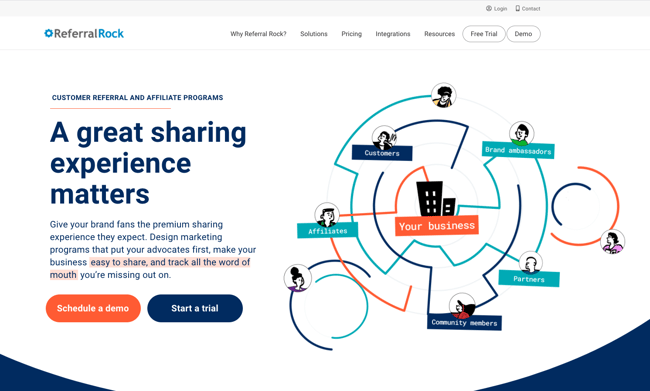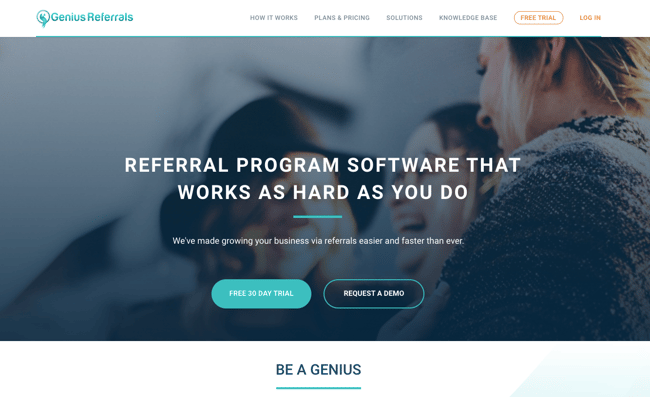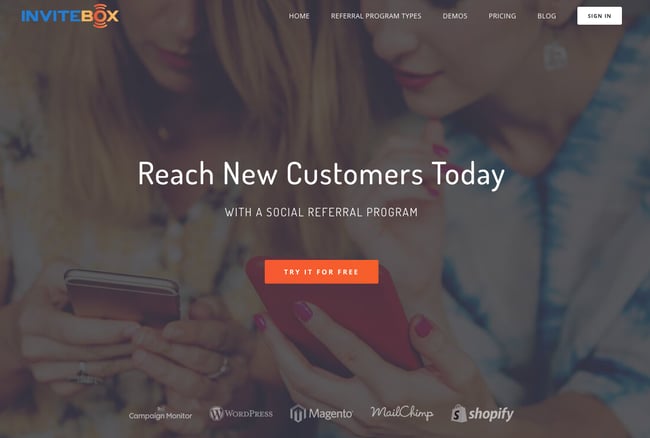What Is Referral Marketing?
Referral marketing is the process of driving word of mouth from existing customers to attract new customers. This is accomplished through various strategies that often include incentives for existing customers (e.g., refer a friend).
We have all benefited from the recommendations a friend or loved one has made to us, at one point or another; when someone says to watch a movie, buy a product, or subscribe to a new service, we listen!
Referral marketing involves taking this abstract concept of word of mouth and transforming it into a tangible strategy to implement for your business. This guide provides you with a comprehensive understanding of this process, how it works, and examples that might be applicable to your business, plus software solutions to suit your needs.
What Is Referral Marketing?
Referral marketing is the official term used to describe the process and benefits of word of mouth marketing. While this originated from literal word of mouth, today’s definition is more technologically inclusive by encouraging social media posts and engagement from your customers.
Basically, when your business provides a kickass product or service, your customers will feel compelled to spread the word to more members of your targeted audience.
What Makes Referral Marketing So Effective?
It’s human nature to trust other humans in recommending quality, worthwhile products and services. In fact, a study from global marketing research firm Nielsen reports that 92 percent of consumers believe word-of-mouth recommendations over any other form of marketing.
By providing a fantastic business to your clients, they will naturally feel excited to benefit from it, and will want to tell others about it, too. You can wholly trust your customers are naturally telling their whole network about your business, right?
Unfortunately, this is only half the battle; while 83 percent of satisfied customers are willing to recommend a business to their friends, only 29 percent actually do. Life happens, people are forgetful, and maybe it just never comes up in conversation for them to spread the word about your business.
Without a proper referral marketing strategy to further nudge your customers to share their delightful experiences with your company, you could be losing business without even realizing it.
How to Implement a Referral Marketing Strategy
In another study, 64 percent of marketing executives indicated that they believe word of mouth is the most effective marketing tool — yet only six percent feel they have a grasp on this strategy.
Here’s how you can become one of the few who have mastered referral marketing:
Establish and Nurture Rapport With Customers.
It wouldn’t make much sense to ask a brand new customer to refer others to your business if they have yet to appreciate your work and dedication.
The first step toward building a brand is to build an awesome brand — one that organically compels your customers to become brand ambassadors.
This includes providing customers with a consistently exceptional experience and brand presence. People will only refer others to your business if they trust the quality they’re buying, and if they feel there will be reciprocal benefit to them for giving you “free” advertising.
Build a Badass Referral Program to Reward Your Customers (and Their Friends).
A referral program can take shape in a couple of ways that will inherently bring your customers back to you, in addition to telling their friends about your business. It should be an offer, discount, or incentive relevant to your business and therefore your customers.
Maybe your coffee shop has a loyalty program where the fifth cup is free, or your online shop offers a discount code when a friend makes a purchase through your special link.
If a brand new customer is the first in their network to discover your business, seeing this designated referral program page or offer will help affirm their hopes of a great experience. New customers might be influenced by indirect referrals with the assumption of “This business already has a referral program, so that must mean a lot of people get directed to them.”
The presence of a referral program might also induce them to ask their friends and network if anyone has already worked with or purchased from your business to cash in on a mutual benefit. This conversation further demonstrates the word of mouth marketing tactic.
Without promotion or visibility, though, nobody will know about your offer. Be sure to make it clear with a sign on the counter in your brick-and-mortar location or an anchored link at the top of your webpage.
By presenting a straightforward and kickass offer where the customer doesn’t have to jump through hoops to feel rewarded, you gain value and a good reputation with them.
Follow Through On Your Offer.
Brand transparency is a crucial part of establishing good faith in customers; people like to know where their coffee beans were picked, or if the shirt they just ordered is hand-printed and made to order.
The same logic follows for referral marketing — when your business presents a great deal for the customer to tell their friends about, it shouldn’t have any trick wording or an unreasonably limited time to redeem.
3 Companies Who Mastered Referral Marketing
There are several brands that dominate the world of referral marketing. Here are a few of the best referral marketing examples from successful companies.
TOMS: The One Day Without Shoes Campaign and Refer a Friend Policy
TOMS footwear started out with founder Blake Mycoskie’s vision and business model where the customer buys a pair of shoes then the company donates a pair to those in need. Customers felt they were part of helping the world and believed in the mission of the company.
Through word-of-mouth — er, walk-of-foot? — TOMS went on to become a hugely successful billion-dollar company because people believed in the product and its purpose, and then shared it with their friends.
One of their most impressive word-of-mouth marketing campaigns was based around their One Day Without Shoes theme. They created a dedicated domain and encouraged people to spend a normal day barefoot so they could see the experience that others were going through in impoverished areas where people did not have access to shoes.
The result: They ran this campaign every year for several years, starting in 2007, and kept their word on the promise — for every person who uploaded their photo of barefeet using the hashtag #withoutshoes#, TOMS donated a pair. In 2015 alone, they gave away a million shoes.
This word of mouth tactic expanded their audience of followers on social media platforms and helped develop a positive reputation for the brand.
In the context of referral marketing, they provide an ongoing promotion in their “refer a friend” policy. By referring a new customer, your friend gets $20 off their first purchase, then you (the referrer) collect $20 in store credit — an easy program to follow that continually engages and expands their target audience.
Stitch Fix: Their Referral Tracking Page and Refer a Friend Guide
Stitch Fix is another company built on referrals. They provide a digital personal stylist experience, where users take a quiz to determine their style. Then, they ship clothes tailored to their preferences, and customers can keep what they want or return what they don’t.
The brand’s marketing efforts are well orchestrated. Not only has your favorite podcast probably endorsed the personally selected clothing box, but you likely have seen their referral program. Stitch Fix sets their current customers up for success. In fact, they wrote a short guide on how to refer friends, making it easy for anyone to access referral links and track their ongoing referrals using a personal referrals page.
Word of mouth is essential for brands like Stitch Fix, thanks to their generous offerings. For every referred customer, the referrer gets a $25 credit for their account, and the friend gets their first styling fee waived.
Given their excellent customer service team, the cool personalized customer experience, and their crazy good incentive to evangelize the business, it’s no wonder the company is dressed for success.
Referral Marketing Software Tools You Can Use
Developing your referral marketing strategy takes a lot of time and effort. Fortunately, there are plenty of software programs that help streamline this process.
Referral Rock

Rating: 4.5 stars
Pricing: Starts at $200 per month
Referral Rock can help any business get more customers using the power of their own network. Online and offline businesses can design incentive-based programs, enroll existing customers and partners, capture the new leads and sales, then issue rewards automatically.
This software automates every step of the process, so businesses can scale and consistently measure the success of referral marketing programs.
Genius Referrals

Rating: 4.4 stars
Pricing: Starts at $45 per month
Genius Referrals supports word of mouth marketing techniques, mostly for local services and small businesses. You can personalize the perfect template for your program in a quick and easy manner.
Plus, they provide a robust knowledge base that helps you make the most of your Genius Referrals account.
InviteBox

Rating: 4.8 stars
Pricing: Starts at $29 per month
InviteBox lets you design and launch a referral program for your online business in minutes, and makes it easy to create many different types of offers for your customers. For example, they enable you to enroll customers in goal-based rewards, giveaways, and contests.
They offer a free 14-day trial, and their pricing ranges from $29 to $199 monthly, which is more affordable for small businesses or startups that might be strapped for cash.
Referral marketing strategies are effective in all industries. No matter your size or market, you can get started now. Simply connect with your customers, develop a program, and start bringing in new customers.
With the right tools and strategy in place, you’re poised for revenue growth.


SK West
I earned my Master’s degree in Art History & Criticism at USF and have published works of journalism, art criticism, and poetry. My passion for writing started with scribbles in crayon and now involves empathetic storytelling that connects with the audience through emotion and eloquence. When not working, I enjoy rollerskating and thrift shopping.